How to Create an FAQ Page? 9 Effective Ways
Learn how to create an effective FAQ page that enhances user experience, addresses common questions and reduces support inquiries, improving customer satisfaction.

Learn how to create an effective FAQ page that enhances user experience, addresses common questions and reduces support inquiries, improving customer satisfaction.

More than 80% of customers make a company’s website their first stop for information. Businesses must ensure their website meets their users’ demands, if not it can lead to frustrating users and overwhelming support teams. The consequences? Lost sales, damaged reputations and missed opportunities for engagement.
Enter the FAQ page—a powerful tool that can transform customer interactions when executed effectively. Let us understand what it takes for businesses to create an exceptional help center. If you’re starting fresh or enhancing an existing page, find actionable insights to make your FAQs stand out.
An FAQ (Frequently Asked Questions) page refers to a dedicated section on a website that addresses common queries about a product, service or organization. It serves as a centralized resource, designed to provide answers to recurring questions efficiently.
FAQ pages anticipate user needs by preemptively addressing them. They typically feature a list of popular questions paired with answers, organized logically for easy navigation. Users can quickly scan the page or utilize a search function to find specific topics. Such help-centered pages reduce the workload on customer support teams and enhance the user experience by offering instant access to essential information.
Key principles:
Explore the benefits of FAQ page to understand how a well-designed page can significantly contribute to your business’s efficiency and customer satisfaction.
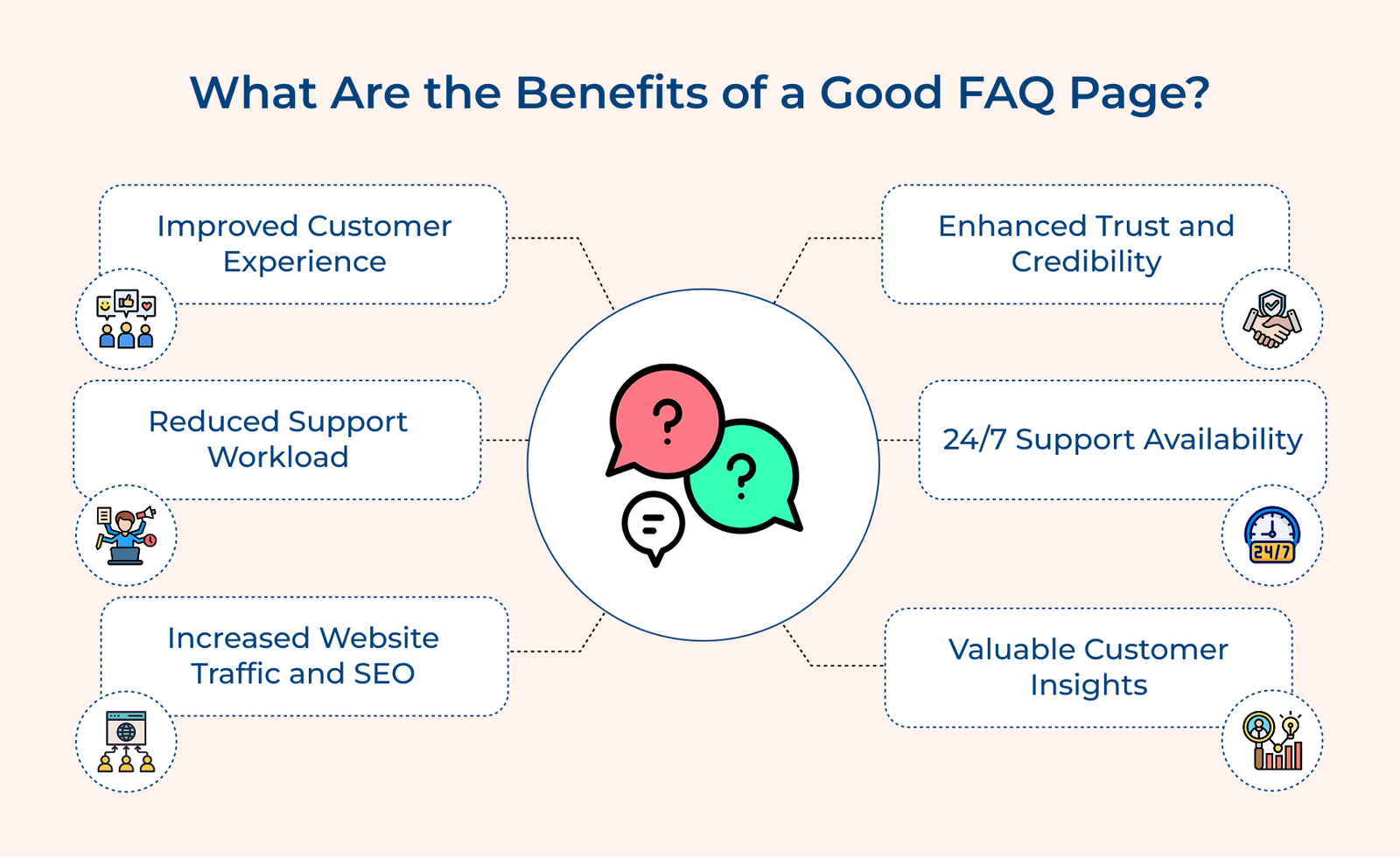
1. Improved customer experience: A well-crafted FAQ page answers common questions instantly, enabling even potential customers to find information quickly and easily. The self-service option boosts user satisfaction by reducing the need for support inquiries, saving time and minimizing frustration.
2. Reduced support workload: Help centers greatly reduce the number of repetitive inquiries sent to customer support by tackling common questions upfront. It enables support staff to concentrate on more complex issues, enhancing efficiency and speeding up responses for urgent matters.
3. Increased website traffic and SEO: FAQ pages are rich in valuable, keyword-targeted content that can boost a website’s search engine rankings. The pages attract organic traffic from users seeking specific information about your products or services by answering common queries.
4. Enhanced trust and credibility: A well-designed help center showcases your expertise and transparency, highlighting your company’s commitment to customer service. You build trust with your audience and position your brand as knowledgeable by proactively addressing potential concerns.
5. 24/7 support availability: 58% of customers expect 24/7 customer support, reflecting the increasing demand for round-the-clock assistance in a globalized marketplace. Unlike human representatives, FAQ pages are available 24/7, allowing customers to access vital information anytime, regardless of time zones or business hour.
6. Valuable customer insights: Help centers provide valuable data on customer needs, preferences and pain points. Businesses can uncover insights that highlight areas for improvement in products, services or communication strategies by analyzing frequently accessed questions and search queries.
The following are the key elements and best practices businesses must consider when designing an FAQ page that not only informs but also enhances the user experience.
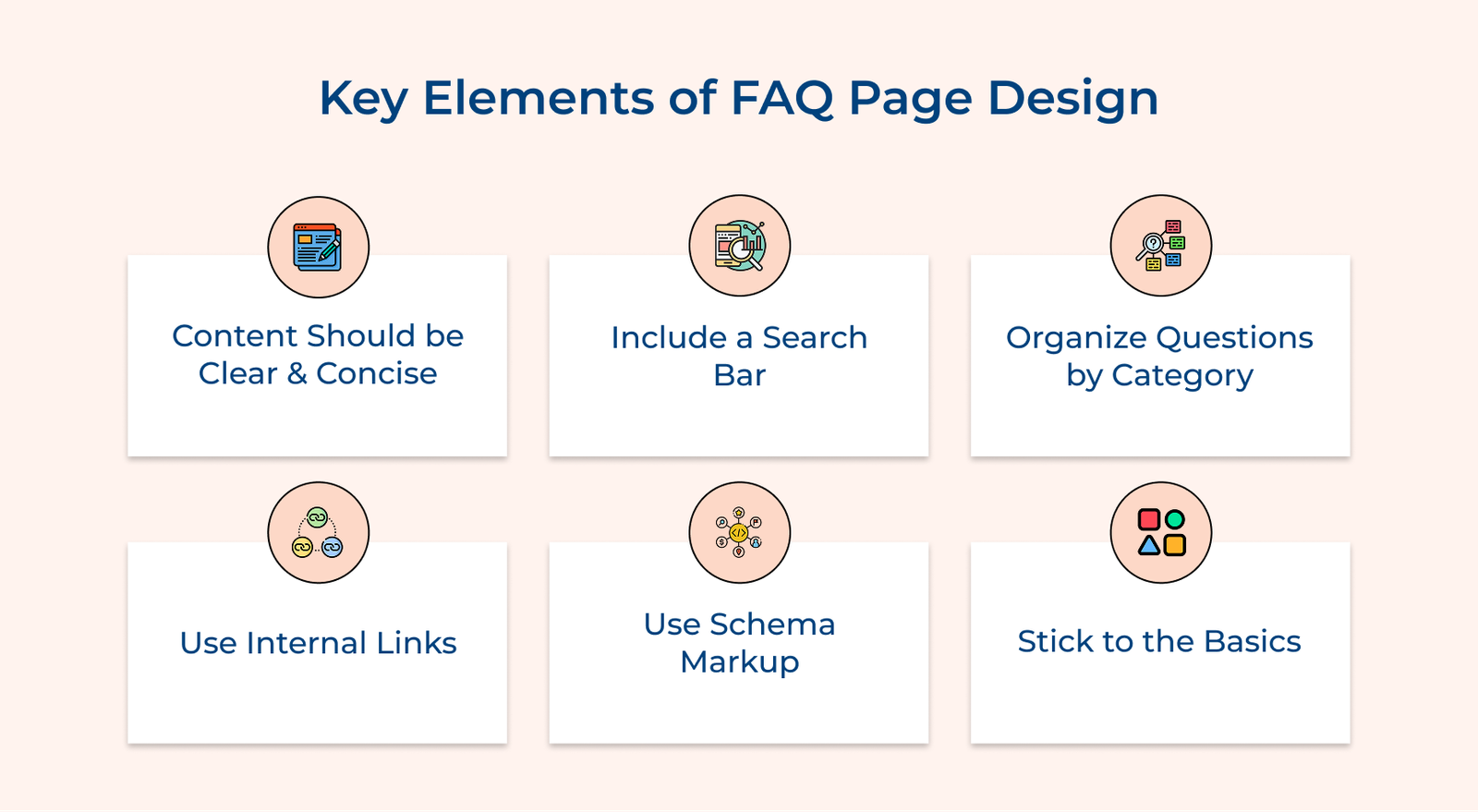
Clear and concise content is essential for an effective FAQ page. Users should be able to quickly scan and grasp the information without wading through unnecessary details or complex language.
Use simple, straightforward language and avoid jargon. Break down complex answers into bullet points or short paragraphs to make the information easily digestible for readers of all expertise levels.
A search bar is a must-have for any help center, especially those with extensive content. It enables users to quickly locate specific information without scrolling through the entire page, saving time and minimizing frustration.
Implement robust search functionality that accommodates various query types, including synonyms and misspellings. Adding auto-suggest features can further assist users in formulating their questions and finding relevant answers more efficiently.
Categorizing questions enhances navigation on your FAQ page, helping users find the information they need without feeling overwhelmed by a long, unorganized list.
Group related questions under clear headings and consider using expandable sections or accordion layouts. It allows users to view all categories at a glance and expand only the relevant sections, creating a more user-friendly interface.
Incorporate internal links within your FAQ answers to guide users to related information on your website. The practice allows visitors to explore relevant content and find more detailed explanations, enhancing their understanding of your products or services.
Internal linking also boosts your website’s SEO by establishing a logical structure and helping search engines understand the relationships between pages. Use descriptive anchor text to provide context and improve usability.
Implementing schema markup for your FAQ page can greatly enhance its visibility in search engine results. The structured data helps search engines better understand and display your FAQ content, potentially leading to rich snippets.
You increase the likelihood of your content appearing in featured snippets or knowledge panels. The improved visibility can drive more traffic to your website and position your brand as an authoritative information source.
Instead of trying to cover every question, focus on the most common and essential inquiries. The approach keeps your content clear and user-friendly, avoiding information overload.
Make it a habit to regularly update your FAQs based on customer feedback and support trends. Remove outdated content and add relevant new questions to ensure your help center remains a valuable, up-to-date resource for users.
Below are the effective steps on how to create a FAQ page that addresses your audience’s needs while reflecting your brand voice.
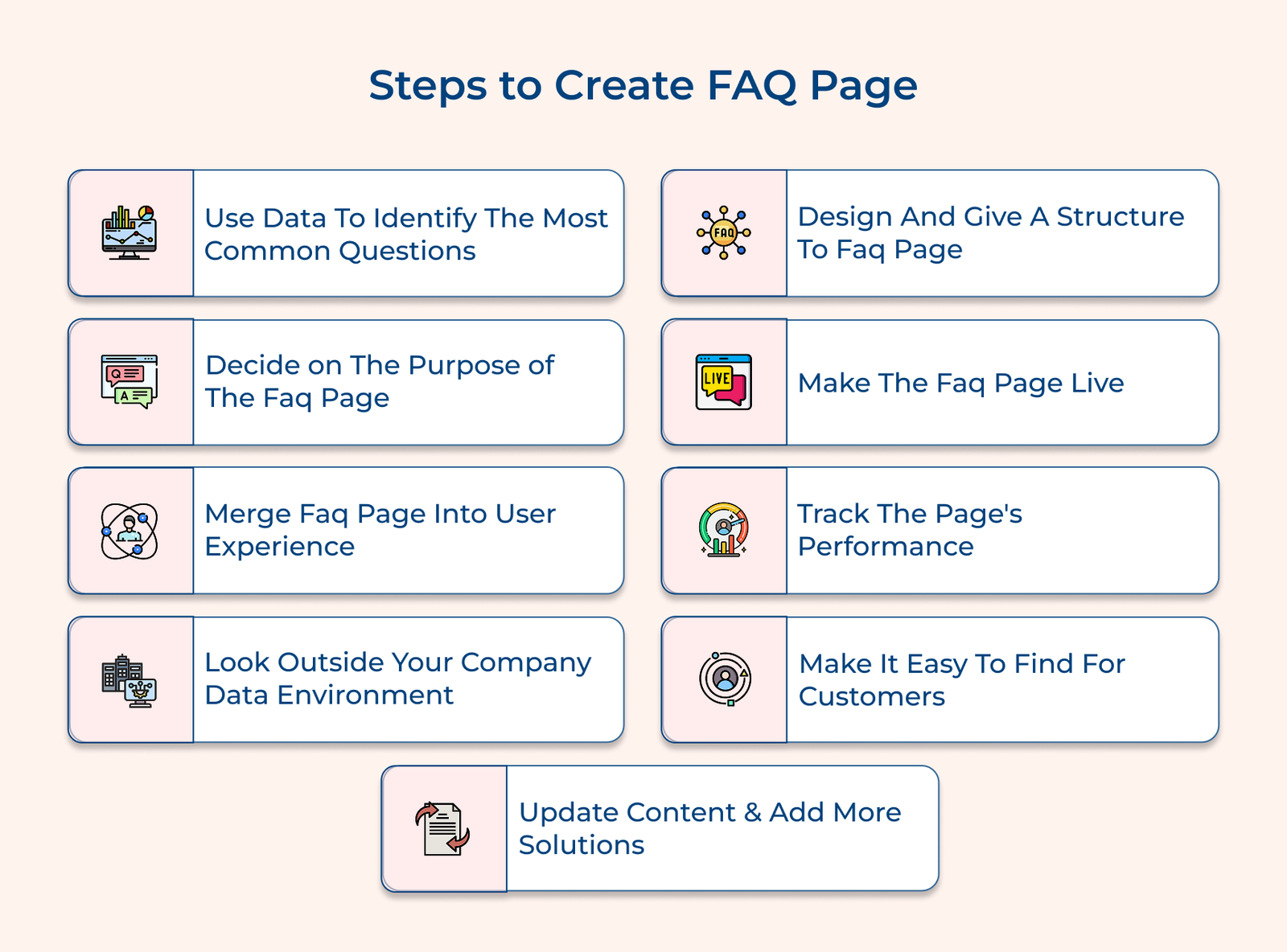
Analyzing customer support tickets reveals valuable insights into recurring issues and questions. You can spot patterns and prioritize the most frequently asked questions for your FAQ page by reviewing the tickets, ensuring it addresses your customers’ biggest concerns.
Delving into chat logs, call transcripts and website search queries further enhances your understanding of customer needs. The sources provide real-time insights into the language your customers use and the specific information they seek. You can create a help center that truly resonates with your audience by incorporating the findings.
Actionable tips:
If your goal is to reduce support tickets, enhance user experience or boost conversions, having specific targets will guide your content and structure. Aligning the objectives with your overall business strategy ensures your help center supports broader company goals.
men
You can tailor your FAQ content to address specific pain points and offer solutions that directly impact your metrics by establishing a clear purpose. The focused approach creates a more effective and valuable resource for your customers while driving your organizational success.
Actionable tips:
The AI-powered tools quickly guide users to relevant information, instantly answer simple queries and offer a more interactive experience. You can create a dynamic resource for your customers by combining FAQ content with digital assistants.
When digital assistants can’t resolve a query, they should easily connect users to human agents. The integration enhances a comprehensive support ecosystem that meets diverse customer needs and preferences.
Actionable tips:
Researching industry trends and common issues expands your perspective beyond internal data. You can anticipate questions and offer innovative solutions in your FAQ by staying informed about broader market challenges. The proactive approach positions your brand as an industry leader.
Analyzing competitors’ FAQ pages and gathering insights from social media or forums adds further value. The external sources can uncover gaps in your content and highlight emerging issues you might have overlooked. You ensure a more comprehensive and relevant help center by incorporating the insights.
Pro tips:
Organizing questions into categories enhances navigation, allowing users to quickly find relevant information. A logical grouping of related topics creates a structured FAQ page, especially beneficial for extensive FAQs, making it easier for users to browse and locate answers efficiently.
Clear and concise language is essential for effective communication. Avoid jargon and complex terms, instead, use simple, straightforward explanations. A user-friendly layout with easy-to-read fonts, ample white space and expandable sections for longer answers further improves readability.
Actionable tips:
Consider placing the page in the main navigation or footer for easy access from any page. Ensure the help center integrates smoothly with your site’s design and navigation for a cohesive user experience.
Mobile responsiveness is crucial in the digital world. Your help center should be easy to read and navigate on various devices or screen sizes. Conduct thorough testing across different devices and browsers to ensure consistent functionality, providing a seamless experience for all users.
Pro tips:
Setting up analytics to monitor user behavior offers valuable insights into how visitors interact with your FAQ page. Track metrics like page views, time on page and bounce rate to see which questions are most popular or how well your content meets user needs.
Measuring key metrics and collecting user feedback is essential for continuous optimization. Implement surveys or feedback forms to gather direct input about users’ experiences with the help center. Combine the qualitative feedback with quantitative data to make informed decisions on content updates.
How to implement:
Place a link in the main navigation bar or footer for maximum visibility and include FAQ links on relevant pages, such as product descriptions or during checkout, to offer context-specific support.
Use relevant keywords in your FAQ content, meta descriptions and page titles. Implement schema markup for FAQs to enhance your search engine results page (SERP) appearance and potentially secure featured snippets, increasing visibility.
Actionable tips:
Set a schedule for content audits to ensure information aligns with your current products, services and policies. Promptly remove outdated details to avoid confusion and maintain your FAQ’s credibility.
Incorporating new questions based on emerging trends shows your commitment to meeting evolving customer needs. Monitor customer support channels, industry developments and user feedback to identify fresh topics for inclusion. Continuously enhance your help center by refining content and structure based on user insights.
Actionable tips:
We’ll explore the key differences between the two vital components of online support and why choosing the right one can significantly enhance user satisfaction.

1. Scope and Purpose
A knowledge base is a comprehensive repository that offers in-depth information about a company’s products, services and processes, covering a wide range of topics, including complex issues or detailed explanations.
An FAQ page targets the most common questions, providing quick, concise answers to typical customer inquiries. It serves as a first point of reference for essential information.
2. Content Structure and Organization
Knowledge bases are typically organized in a hierarchical structure, featuring categories, subcategories and searchable content. They often include a robust search function and navigation system, helping users quickly find specific information within a vast array of topics.
Help centers tend to have a simpler layout, usually presented as a list of questions with corresponding answers. While they may be grouped into broad topics, they generally lack the depth and complexity found in a knowledge base.
3. Depth of Information
Knowledge-based articles are typically detailed, offering step-by-step guides, tutorials and in-depth explanations. They often incorporate multimedia elements like videos, diagrams and interactive content to enhance understanding.
FAQ pages deliver concise, direct answers to specific questions. The content is brief and designed for immediate problem-solving rather than extensive learning.
4. User Interaction and Experience
Knowledge bases promote self-service, enabling users to dive deep into topics and learn at their own pace. They often feature interactive elements like related articles, user forums and options for providing feedback or rating content.
Help centers are designed for quick reference and immediate answers. Users typically scan a list of questions to find their specific query, expecting straightforward answers without the need to navigate through multiple pages or sections.
5. Maintenance and Updates
Maintaining a knowledge base demands ongoing effort and resources. It involves regularly adding new content, updating existing articles and ensuring all information stays accurate as offerings evolve.
FAQ pages require less frequent updates. They are typically revised periodically to reflect new common inquiries or changes in products and services, focusing on keeping the most frequently asked questions current rather than expanding the content scope.
We’ve curated real-life examples of standout FAQ pages that have mastered the art of information delivery.
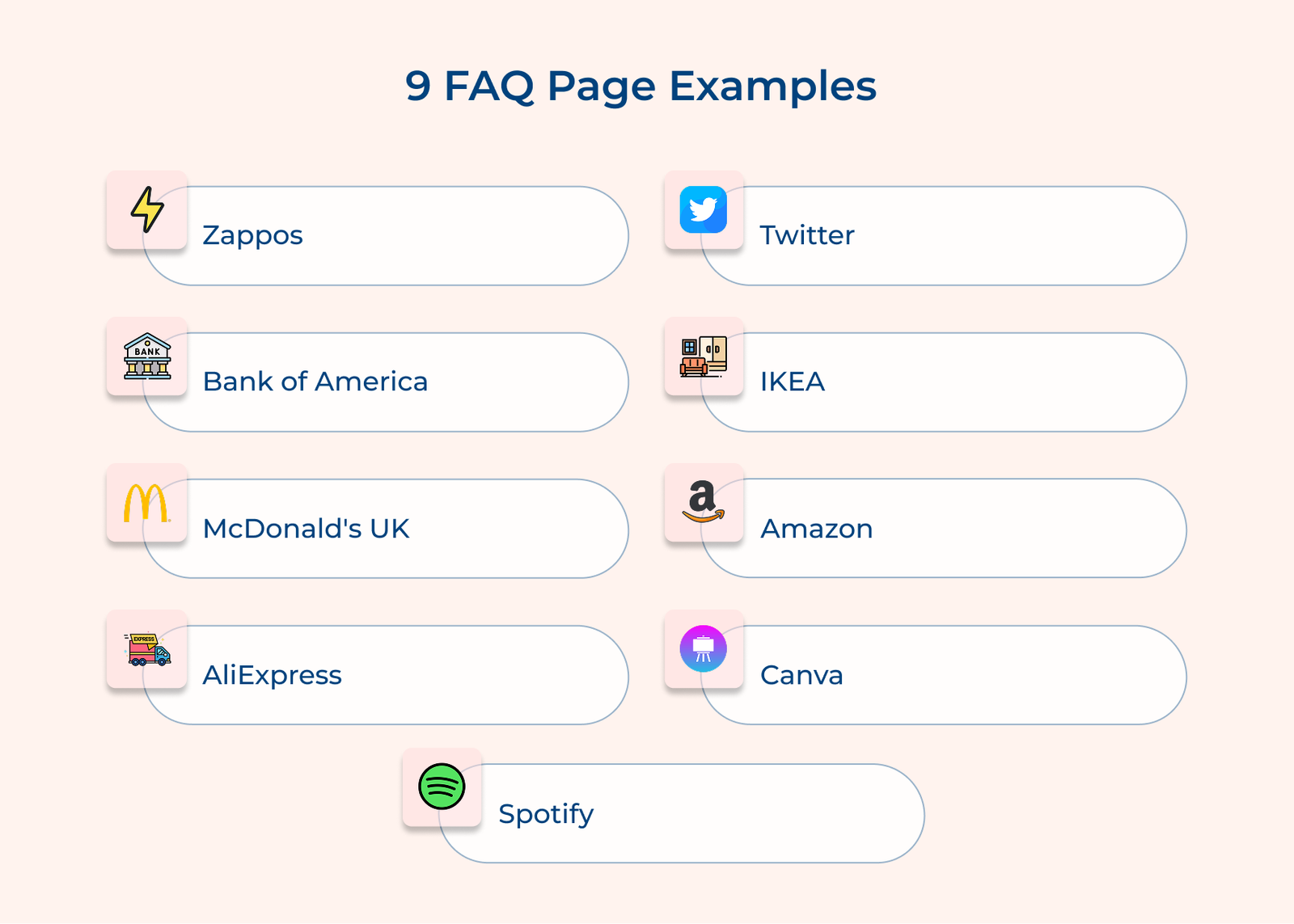
Zappos
Zappos’ FAQ page is a valuable resource for customers, addressing common questions about ordering, shipping, returns and account management. Its primary goal is to provide quick answers, reduce the need for direct customer support and enhance the shopping experience.
The design of Zappos’ help center is user-friendly, featuring a prominent search bar at the top and categorized sections with expandable questions. The straightforward layout makes it easy for users to navigate and quickly find the information they need.
What’s unique:
Bank of America
Bank of America’s FAQ page is dedicated to answering common banking queries, covering topics like account management, online banking, loans and security. Its goal is to empower customers with self-service options and reduce routine inquiries to customer service.
The design is professional and organized, featuring a clean layout with a prominent search function. Questions are grouped into clear sections and the use of text and icons enhances navigation.
Key learnings:
McDonald’s UK
McDonald’s UK FAQ page tackles questions about their menu, nutritional information, restaurant operations and company policies. Its goal is to provide transparency about its products and practices while offering quick answers to customer inquiries.
The design is visually appealing, showcasing McDonald’s brand colors and imagery. It features a user-friendly interface with a search bar and categorized questions, all within a responsive layout for a seamless experience across devices.
What’s unique:
AliExpress
AliExpress’s FAQ page addresses key concerns related to international shopping, payments, shipping and buyer protection. Its aim is to build customer trust and clarify its unique e-commerce model, which connects buyers with global sellers.
The design is straightforward and functional, with clearly categorized topics. It features a search bar and accordion-style expandable sections for answers, maintaining AliExpress’s brand identity while prioritizing readability.
Things to note:
Twitter’s FAQ page addresses a variety of topics, including account management, privacy settings and platform features. Its goal is to help users effectively navigate the platform by addressing common issues and promoting best practices.
The design is minimalist and intuitive, reflecting Twitter’s brand aesthetic. It includes a prominent search bar and categorized sections with clear, concise answers, all optimized for a responsive layout that works seamlessly on both desktop along mobile devices.
What’s unique:
IKEA
IKEA’s FAQ page tackles questions about products, ordering, delivery, assembly and returns, aiming to provide comprehensive support throughout the shopping journey, from selection to after-sales service.
The design is visually appealing, utilizing IKEA’s signature colors and typography. It features a search function and well-organized categories, with expandable sections for detailed answers. The responsive layout ensures a consistent experience across all devices.
The standouts:
Amazon
Amazon’s FAQ page addresses a wide range of topics, including ordering, shipping, returns, Prime membership and device support. Its goal is to provide quick answers to common questions, easing the burden on customer service and enhancing the shopping experience.
The design is straightforward and functional, prioritizing usability over visual flair. It features a robust search function and well-organized categories. While information is dense, clear headings and links ensure easy navigation.
Key points:
Canva
Canva’s FAQ page addresses questions about using their design platform, account management and subscription options. Its goal is to help users maximize Canva’s features and quickly resolve common issues, enhancing their design experience.
The design is visually appealing, showcasing Canva’s signature colors and clean aesthetic. It combines icons, categorized sections and a search function to help users find information quickly.
Key learnings:
Spotify
Spotify’s FAQ page tackles questions about account management, subscription plans, playback issues and device compatibility. Its goal is to provide quick solutions to common problems, ensuring a smooth listening experience across various platforms.
The design is sleek and modern, reflecting Spotify’s brand identity. It features a prominent search bar and well-organized categories with expandable answers. The user-friendly layout is responsive, adapting seamlessly to different screen sizes.
The standouts:
Customers demand quick and easy access to information. A well-crafted FAQ page is essential for meeting expectations, providing instant answers to common questions and minimizing frustration. Businesses can enhance user experience and build trust by anticipating customer concerns.
Effective help centers offer multiple benefits. They reduce the workload on customer support teams, allowing them to focus on more complex issues. FAQ pages also boost SEO by targeting common search queries, potentially driving more traffic to your site. They also serve as a valuable resource for customers at every stage of their journey.
An FAQ page is designed to tackle common questions and concerns from website visitors. It acts as a self-service resource, minimizing customer support inquiries and enhancing user experience. Help centers offer quick answers to FAQs, making it easy for users to find information while building trust through demonstrated knowledge.
FAQ pages are usually positioned in easily accessible areas on a website. Common placements include the main drop down menu, footer or a prominent link on the homepage. FAQs can be integrated into product pages or the checkout process for e-commerce sites. Many websites also feature a dedicated “Help” or “Support” section that includes FAQs.
Absolutely, help centers are great for SEO. They allow you to target long-tail keywords or question-based searches, enhancing user engagement and reducing bounce rates by directly addressing queries. Using schema.org structured data for FAQ content can also help you earn featured snippets in search results, boosting visibility even further.
An effective FAQ page should feature genuinely common questions with clear, concise answers. It should cover key topics like product information, pricing, shipping, returns, account management and technical issues. FAQs need to be organized logically, use plain language and be regularly updated. Adding a search function and links to more detailed resources can further enhance usability.
Building an effective help center is crucial for improving user experience on your website. Key questions to address include: What products or services do you offer? How can I contact customer support? What are your shipping and return policies? Do you have a privacy policy? How do I track my order? Include industry-specific queries to provide thorough answers for your audience.
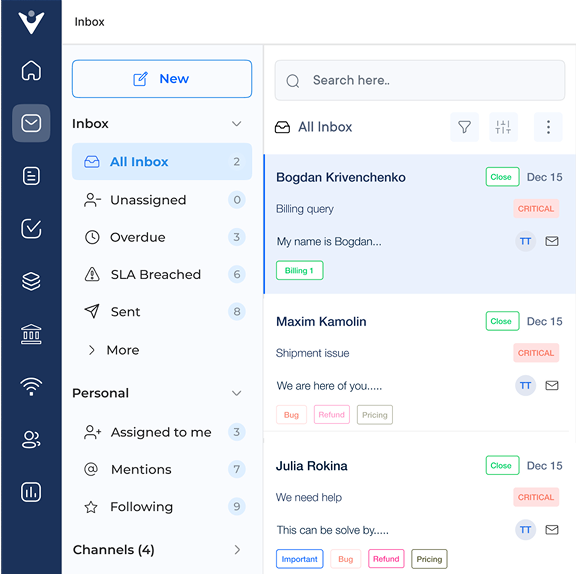
Market better, sell faster and support smarter with Veemo’s Conversation Customer Engagement suite of products.
Unify all your customer data in one platform to deliver contextual responses. Get a 360 degree view of the customer lifecycle without switching tools.
Connect with the tools you love to reduce manual activities and sync your business workflows for a seamless experience.
 https://veemo.io/wp-content/uploads/2024/12/customer-service-response-time.png
1256
2400
Webvision Solution
https://veemo.io/wp-content/uploads/2024/11/veemo.svg
Webvision Solution2025-10-17 10:51:142025-10-17 10:51:149 Effective Tips to Reduce Customer Service Response Time
https://veemo.io/wp-content/uploads/2024/12/customer-service-response-time.png
1256
2400
Webvision Solution
https://veemo.io/wp-content/uploads/2024/11/veemo.svg
Webvision Solution2025-10-17 10:51:142025-10-17 10:51:149 Effective Tips to Reduce Customer Service Response Time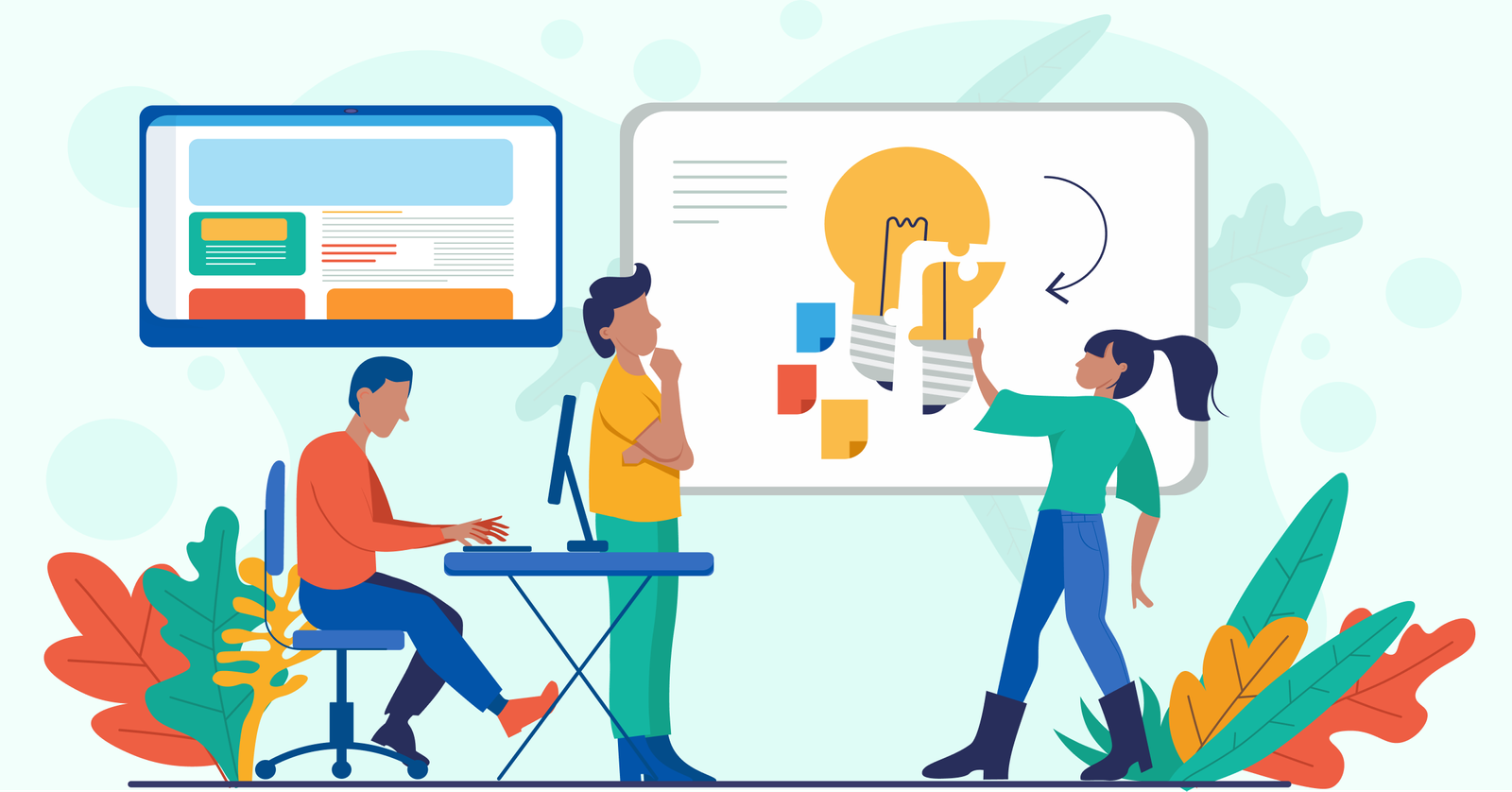 https://veemo.io/wp-content/uploads/2024/10/How-to-Create-Knowledge-Base.png
1257
2400
Vikas Sachan
https://veemo.io/wp-content/uploads/2024/11/veemo.svg
Vikas Sachan2024-10-21 12:24:342025-11-03 07:13:21How to Create a Knowledge Base in 9 Easy Steps: The Ultimate Guide
https://veemo.io/wp-content/uploads/2024/10/How-to-Create-Knowledge-Base.png
1257
2400
Vikas Sachan
https://veemo.io/wp-content/uploads/2024/11/veemo.svg
Vikas Sachan2024-10-21 12:24:342025-11-03 07:13:21How to Create a Knowledge Base in 9 Easy Steps: The Ultimate Guide https://veemo.io/wp-content/uploads/2024/02/Live-Chat-for-Sales.png
628
1200
teamwebvisionsolution@gmail.com
https://veemo.io/wp-content/uploads/2024/11/veemo.svg
teamwebvisionsolution@gmail.com2024-10-21 11:31:222025-08-06 10:22:06How to Use Live Chat for Sales? 7 Proven Ways to Grow Revenue
https://veemo.io/wp-content/uploads/2024/02/Live-Chat-for-Sales.png
628
1200
teamwebvisionsolution@gmail.com
https://veemo.io/wp-content/uploads/2024/11/veemo.svg
teamwebvisionsolution@gmail.com2024-10-21 11:31:222025-08-06 10:22:06How to Use Live Chat for Sales? 7 Proven Ways to Grow RevenueGrow Customer Relationships and stronger team collaboration with our range of products across the Conversational Engagement Suite.

 10 Effective Ways to Improve Customer Service Security
Scroll to top
10 Effective Ways to Improve Customer Service Security
Scroll to top